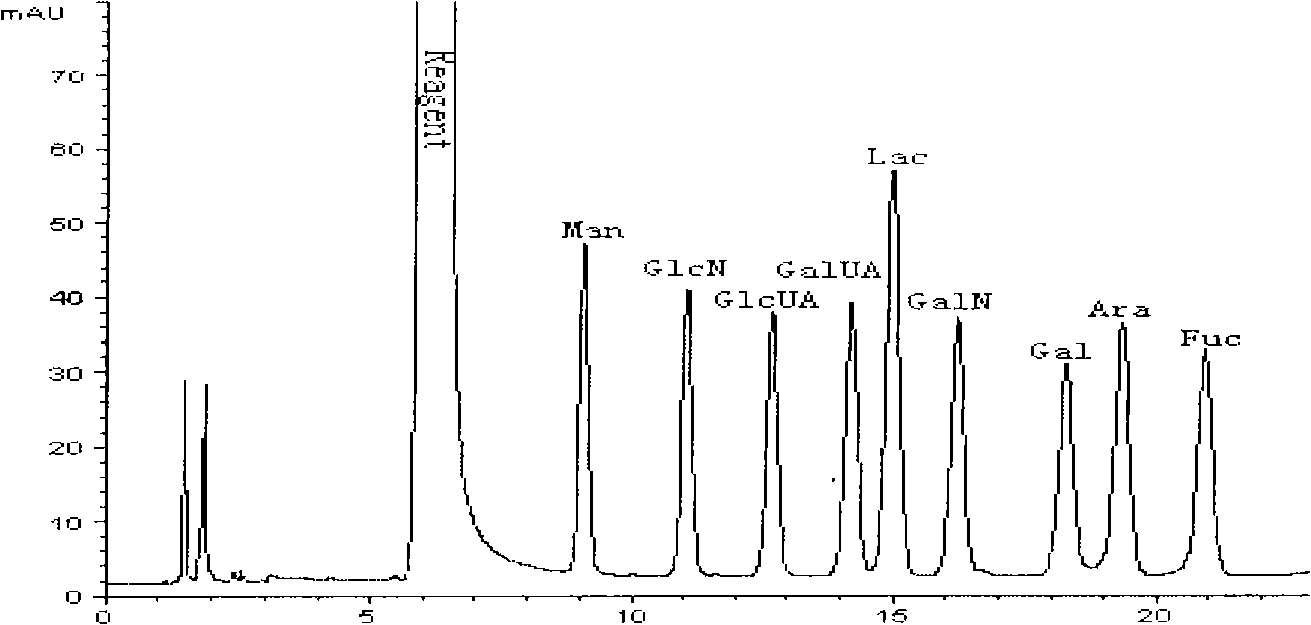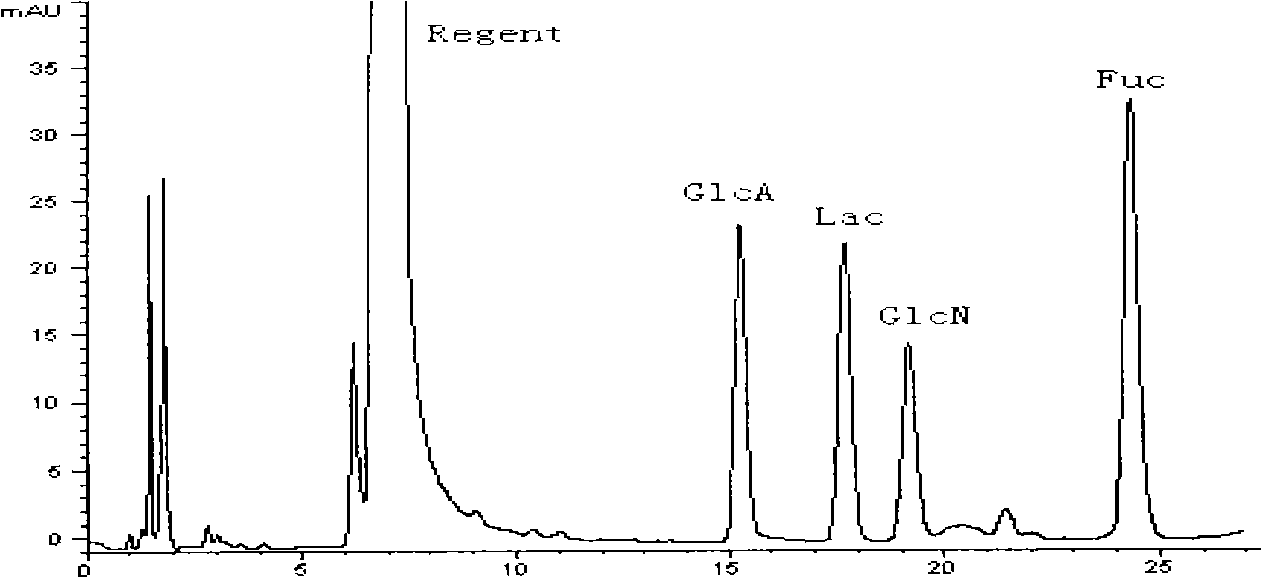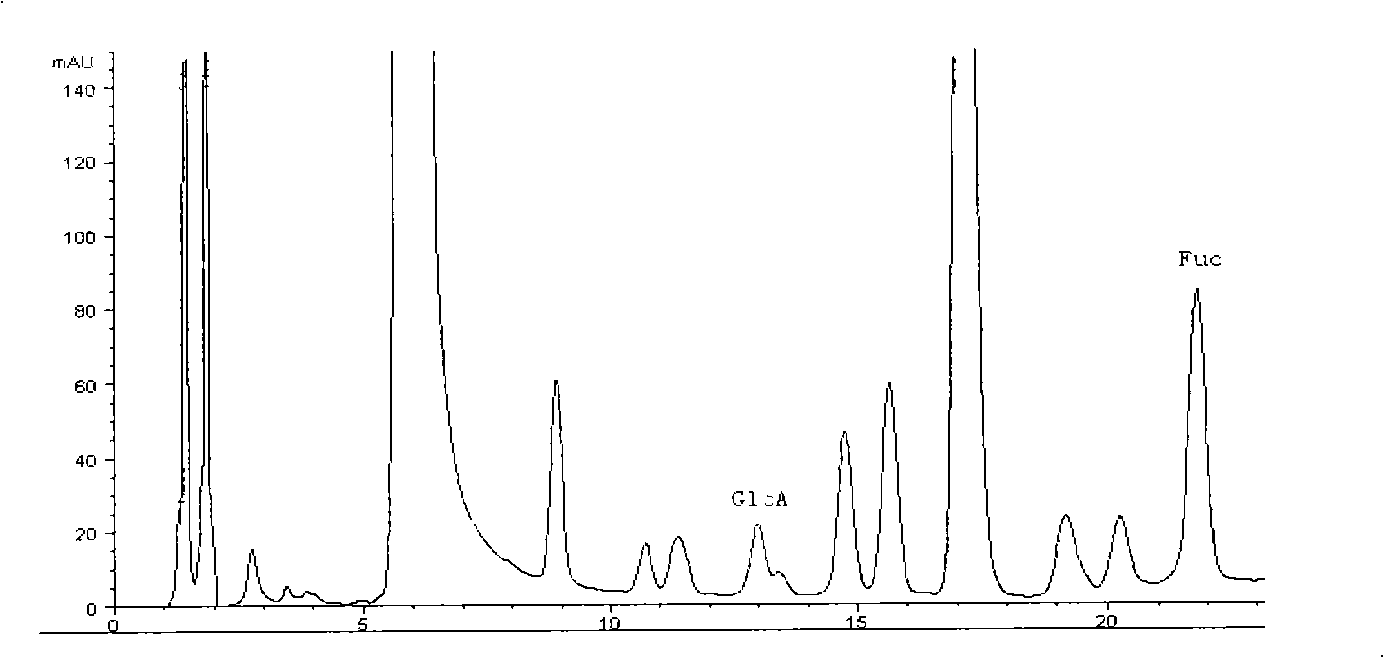Sea pumpkin and sea pumpkin product sea pumpkin polysaccharide content determination method
A technology of sea cucumber polysaccharide and determination method, applied in the directions of measuring device, biological test, material inspection product, etc., can solve the problems of complex variety and difficult to satisfy, and achieve the effects of good stability, short detection time and high sensitivity
- Summary
- Abstract
- Description
- Claims
- Application Information
AI Technical Summary
Problems solved by technology
Method used
Image
Examples
Embodiment 1
[0010] The mensuration of polysaccharide content in the sea cucumber peptide of embodiment 1
[0011] (1) Accurately weigh 6g of sample A sea cucumber peptide, grind it finely, add 30ml of sodium acetate buffer solution with a concentration of 0.05M / L, pH 6 and 100mg of papain, react at 37°C for 24h, centrifuge, and take Add 2 times the volume of ethanol to the clear liquid to precipitate the sea cucumber polysaccharide produced after enzymatic hydrolysis, dissolve the precipitate obtained by centrifugation with water, and dilute to 3ml;
[0012] (2) Take 0.5ml of the obtained liquid and add an equal volume of 2mol / L trifluoroacetic acid (TFA) aqueous solution to hydrolyze at 120°C for 2 hours, dry the obtained hydrolyzate with nitrogen, neutralize with 0.3M aqueous sodium hydroxide solution, and After distilling to 2ml, it was used as the sample test solution.
[0013] (3) Accurately weigh the fucose standard substance with water to prepare a 1 mmol / L aqueous solution as a s...
Embodiment 2
[0017] The mensuration of sea cucumber polysaccharide content in dry sea cucumber of embodiment 2
[0018] (1) Accurately weigh 10 g of commercially available dry ginseng (Apostichopus japonicus) sample B, add 60 ml of sodium acetate buffer solution with a concentration of 0.05 M / L and a pH of 7.5 and 1 g of trypsin for enzymolysis at 60°C for 24 hours, and digest the obtained enzyme After the solution was centrifuged, 3 times the volume of ethanol was used to precipitate the sea cucumber polysaccharide in the obtained supernatant, and the obtained precipitate was adjusted to 5 ml.
[0019] (2) Take 0.5ml of the above liquid, add an equal volume of 6mol / L TFA, seal the tube with nitrogen, and hydrolyze at 110°C for 8h; Sample for test solution.
[0020] (3) Get 250 μ L of the test solution, carry out derivation and liquid chromatography separation according to (3)-(5) steps in Example 1, and obtain the relevant working curve y=9675x+9.0095 (R 2 = 0.9986). The measured peak ...
Embodiment 3
[0021] The mensuration of sea cucumber polysaccharide content in the sea cucumber granule of embodiment 3
[0022] (1) Take 1 g each of sea cucumber granule sample C and sea cucumber granule sample D, add 60 ml of potassium acetate buffer solution with a concentration of 0.05M / L and pH of 6.5 and add 1 mg of papain for enzymolysis, centrifuge the obtained enzymatic hydrolyzate, and use 2 times the volume of ethanol to precipitate the sea cucumber polysaccharide in the obtained supernatant, centrifuge, and settle the precipitate to 100ml.
[0023] (2) Take 0.5ml of the above liquid, add an equal volume of 1mol / L trifluoroacetic acid, seal the tube with nitrogen, and hydrolyze at 110°C for 1 hour; dry the hydrolyzate with nitrogen, neutralize it with 0.3M sodium hydroxide, and set the volume to 2ml Provide the test solution for the sample.
[0024] Get 250 μ L of test solution, carry out derivation and liquid chromatography separation according to (3)-(5) step in embodiment 1, ...
PUM
 Login to View More
Login to View More Abstract
Description
Claims
Application Information
 Login to View More
Login to View More - R&D
- Intellectual Property
- Life Sciences
- Materials
- Tech Scout
- Unparalleled Data Quality
- Higher Quality Content
- 60% Fewer Hallucinations
Browse by: Latest US Patents, China's latest patents, Technical Efficacy Thesaurus, Application Domain, Technology Topic, Popular Technical Reports.
© 2025 PatSnap. All rights reserved.Legal|Privacy policy|Modern Slavery Act Transparency Statement|Sitemap|About US| Contact US: help@patsnap.com



